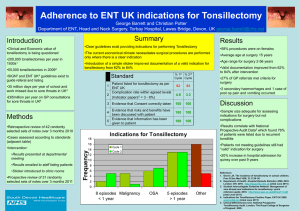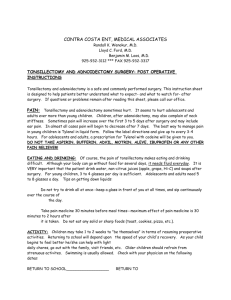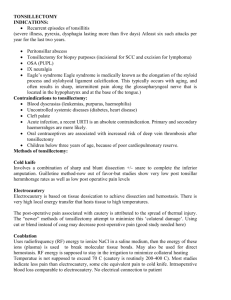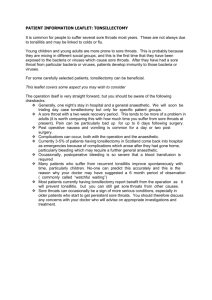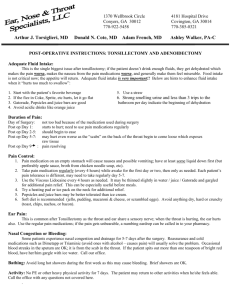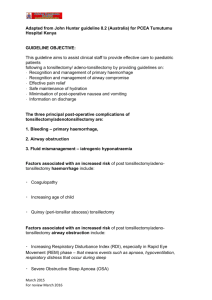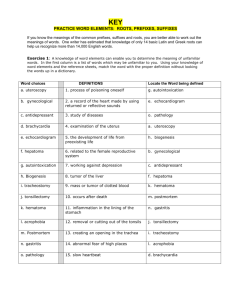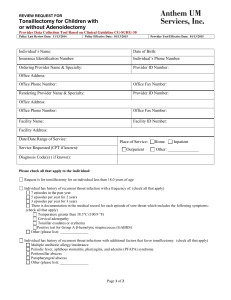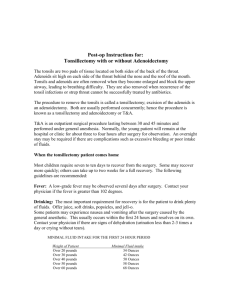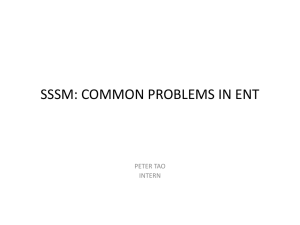Commissioning guide : tonsillectomy
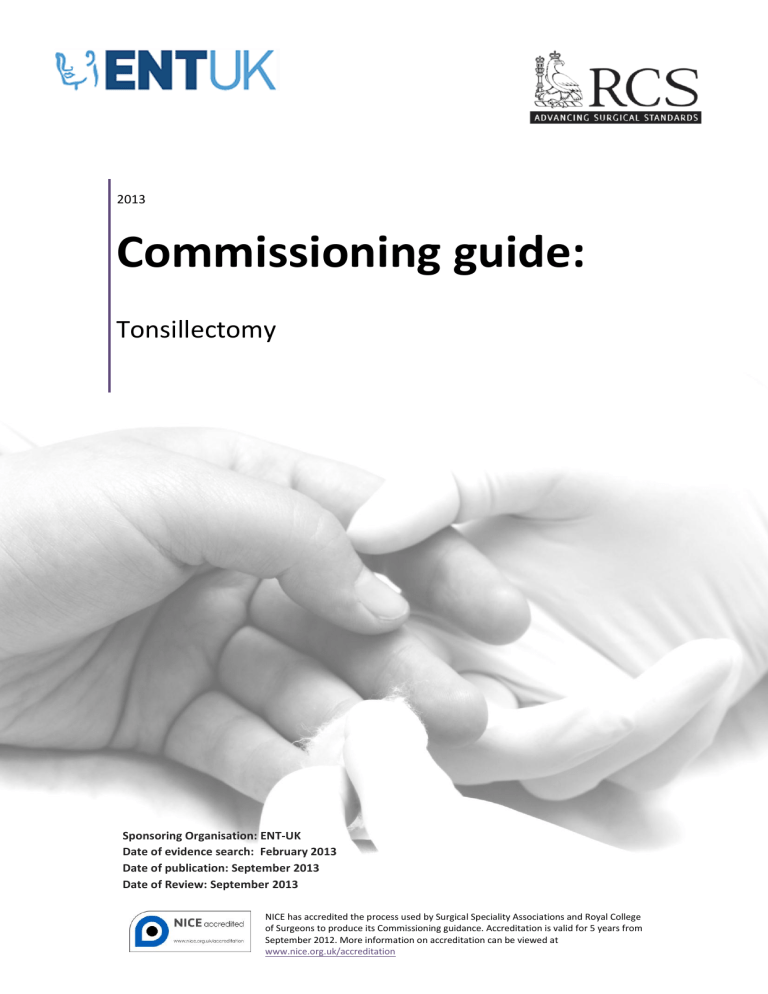
2013
Commissioning guide:
Tonsillectomy
Sponsoring Organisation: ENT-UK
Date of evidence search: February 2013
Date of publication: September 2013
Date of Review: September 2013
NICE has accredited the process used by Surgical Speciality Associations and Royal College of Surgeons to produce its Commissioning guidance. Accreditation is valid for 5 years from
September 2012. More information on accreditation can be viewed at www.nice.org.uk/accreditation
Commissioning guide 2013
Tonsillectomy
CONTENTS
4.2 Quality Specification/CQUIN…………………………………………………………………………………………………………………………………………….5
7.1 Research recommendations…………………………………………………………………………………………………………………………………………….7
7.2 Other recommendations………………………………………………………………………………………………………………………………………………..7
7.3 Evidence base………………………………………………………………………………………………………………………………………………………………….7
7.5 Funding statement………………………………………………………………………………………………………………………………………………………………………………9
The Royal College of Surgeons of England, 35-43 Lincoln’s Inn Fields, London WC2A 3PE
1
Commissioning guide 2013
Tonsillectomy
Introduction
This commissioning guide comprises two pathways of care which culminate in tonsillectomy:
Recurrent tonsillitis or its complications (e.g. quinsy) in children <16 and in adults
Sleep disordered breathing in children <16
Recurrent acute sore throat is a very common condition presenting in primary care and tonsillectomy is one of the most common operations. It presents a significant burden of disease; in 2012 some 13,000 operations per year were performed in adults and 18,000 operations per year in children, incurring a cost of £51m across
England.
There is an inequality of care demonstrated by widespread variation in the number of operations across the country; this makes an understanding of the pathway of care for this group of patients a commissioning priority.
For tonsillectomy there is good evidence addressing effectiveness in children; but limited evidence in adults.
1 High Value Care Pathway for tonsillectomy
This section provides two pathways:
1.1 High Value Care Pathway for recurrent tonsillitis or its complications (eg. quinsy) in children <16 and in adults
Primary care assessment
Carefully assess (history and examination) a patient with sore throat symptoms and document diagnosis of significant sore throat or tonsillitis.
Carefully assess and document impact on quality of life.
Referral
Consider referral if SIGN criteria are met (i.e. 7 or more clinically significant, adequately treated sore throats in the preceding 12 months or 5 or more episodes in each of the preceding two years, or 3 or more in each of the preceding three years)
.
There are a small proportion of patients with specific clinical conditions or syndromes, who require tonsillectomy as part of their on-going management strategy, and who will not necessarily meet the SIGN
2
Commissioning guide 2013
Tonsillectomy guidance (e.g. those presenting with psoriasis, nephritis, PFAPA syndrome)
Before referral to secondary care, discuss with patient/parents or carers the benefits and risks of tonsillectomy vs. watchful waiting. Information to be provided and reassurance given if no further treatment or referral for tonsillectomy is deemed necessary at this stage. This discussion should be documented.
The impact of recurrent tonsillitis on a patient’s quality of life and ability to work should be taken into consideration. A fixed number of episodes, as described above, may not be appropriate for adults with severe or uncontrolled symptoms, or if complications (eg quinsy) have developed.
Secondary care
Confirmation of primary care assessment, fulfilment of SIGN criteria for tonsillectomy and impact on quality of life and ability to work/attend school.
Consultation with patient about management options using shared decision making strategies and tools where appropriate.
Management options: tonsillectomy, or referral back to primary care for on-going monitoring.
Surgical setting
Children : Ideally within a paediatric surgical facility as a day case, although day case care may be contraindicated in the presence of significant sleep apnoea
Adults : Ideally as a day case.
1.2 High Value Care Pathway: Children (<16) with sleep disordered breathing
Primary care assessment
Carefully assess (history and examination) a child with symptoms of significant snoring and disruptive breathing patterns whilst asleep. Make note of large tonsils with or without nasal obstruction.
Carefully assess and document impact on development, behaviour and quality of life.
Referral
If sleep disordered breathing is suspected, refer to secondary care.
Secondary care
Confirmation of primary care assessment, either on basis of history and examination or, if necessary, findings from further investigations (e.g. Sleep study)
3
Commissioning guide 2013
Tonsillectomy
Consider impact on quality of life, behaviour and development.
Consultation with parent/carers about management options using shared decision making strategies and tools where appropriate.
Management options: tonsillectomy or adenotonsillectomy, or, if appropriate, referral to paediatrician or discharge back to primary care.
Surgical setting
Within a paediatric surgical facility. Children with severe symptoms will need access to paediatric intensive care facilities.
2 Procedures explorer for tonsillectomy
Users can access further procedure information based on the data available in the quality dashboard to see how individual providers are performing against the indicators. This will enable CCGs to start a conversation with providers who appear to be 'outliers' from the indicators of quality that have been selected.
The Procedures Explorer Tool is available via the Royal College of Surgeons website.
3 Quality dashboard for tonsillectomy
The quality dashboard provides an overview of activity commissioned by CCGs from the relevant pathways, and indicators of the quality of care provided by surgical units.
The quality dashboard is available via the Royal College of Surgeons website.
4
Commissioning guide 2013
Tonsillectomy
4 Levers for implementation
4.1 Audit and peer review measures
The following measures and standards are those expected at primary and secondary care. Evidence should be able to be made available to commissioners if requested.
Measure Standard
Primary Care Documentation of symptoms
Referral
Secondary
Care
Patient information
Patient engagement and information
Criteria for surgery
Criteria for non-day case decisions
Audit
Significant symptoms should be documented prior to referral
Do not refer patients who do not fulfil criteria for referral unless exceptions as above.
Patients are provided with appropriate information prior to referral
Evidence of patient’s engagement in shared decision making process and provision of written patient information
Evidence of appropriate documentation that patients fulfil criteria for surgery
Evidence of appropriate documentation supporting any non-day case decision
Audit of:
post-operative complications and morbidity
appropriate peri- and post-operative management (pain control, post-discharge information, etc.)
4.2 Quality Specification/CQUIN
Measure Description
Length of stay
Day Case Rates
Unplanned readmissions within
14 days
Data specification
(if required)
Data available from HES Provider demonstrates a mean
LOS of <2 days
Provider demonstrates day case is the expectation
Provider demonstrates low readmission rates within 14 days: up to 15% is acceptable for post-operative pain/bleeding)
Adequate justification for non day case rate
Data available from HES
5
Commissioning guide 2013
Tonsillectomy
5 Directory
5.1 Patient Information for tonsillectomy
Name
Shared decision making tool
Publisher
Right Care
Link http://sdm.rightcare.nhs.uk/pda/recurrentsore-throat/
ENT-UK Patient
Information leaflet on tonsillectomy
Tonsillitis
ENT-UK
NHS Choices https://entuk.org/ent_patients/information
_leaflets http://www.nhs.uk/conditions/tonsillitis/pa ges/treatment.aspx
5.2 Clinician information for tonsillectomy
Name Publisher Link
Management of sore throat and indications for tonsillectomy
A national clinical guideline
Prescribing of antibiotics for self-limiting respiratory tract infections in adults and children in primary care
Clinical Knowledge Summary:
Acute Sore Throat
SIGN
NICE http://www.sign.ac.uk/pdf/sign117.pdf
http://www.nice.org.uk/CG69
NICE http://cks.nice.org.uk/sore-throat-acute
Management
6 Benefits and risks of implementing this guide
Consideration Benefit
Patient outcome Ensure tonsillectomy is only undertaken on patients with significant symptoms
Risk
As guidelines are well defined, some patients who might otherwise have benefitted from tonsillectomy will not have been offered the procedure (see section 1).
6
Commissioning guide 2013
Tonsillectomy
Patient safety Patients receive appropriate information about their condition and treatment.
Patient experience
Equity of Access
Improve access to patient information
Improve access to effective procedures for those most likely to benefit
Resource impact Reduce unnecessary referral and intervention
Reduce unnecessary societal costs of recurrent tonsillitis
7 Further information
HES data indicate that as tonsillectomy rates have fallen in the UK there has been a corresponding annual increase in acute hospital admissions with tonsillitis and its complications.
To deny access to some patients who might otherwise have benefitted from tonsillectomy.
Increased activity in primary and secondary care in managing acute sore throats.
Costs of potential increased surgical activity
7.1 Research recommendations
Research on development of a PROM for recurrent sore throat
RCT of tonsillectomy in adults with recurrent tonsillitis
Development of most clinical and cost effective peri and post-operative clinical protocols
7.2 Other recommendations
Recommendation that PROMs for recurrent tonsillitis is developed and implemented.
7.3 Evidence base
1.
SIGN. Management of sore throat and indications for tonsillectomy. Edinburgh: Scottish Intercollegiate
Guidelines Network; 2010. Report No.: 117.
2.
RCSEng. National prospective tonsillectomy audit: final report of an audit carried out in England and
Northern Ireland between July 2003 and September 2004. London: Royal College of Surgeons of England;
2005.
3.
Burton MJ, Glasziou PP, Burton MJ, Glasziou PP. Tonsillectomy or adeno-tonsillectomy versus non-surgical
7
Commissioning guide 2013
Tonsillectomy treatment for chronic/recurrent acute tonsillitis. [Review] [20 refs][Update of Cochrane Database Syst Rev.
2000;(2):CD001802; PMID: 10796824]. Cochrane Database of Systematic Reviews 2009;(1):CD001802.
4.
Wilson JA, Steen IN, Lock CA, Eccles MP, Carrie S, Clarke R, et al. Tonsillectomy: a cost-effective option for childhood sore throat? Further analysis of a randomized controlled trial. Otolaryngology - Head & Neck
Surgery 2012 Jan;146(1):122-8
5.
Alkhalil M, Lockey R, Alkhalil M, Lockey R. Pediatric obstructive sleep apnea syndrome (OSAS) for the allergist: update on the assessment and management. [Review]. Annals of Allergy, Asthma, & Immunology
2011 Aug;107(2):104-9.
6.
Marcus CL, Books LJ, Draper KA, Gozal D, Halbower AC, Jones J, et al. Diagnosis and Management of
Childhood Obstructive Sleep Apnea Syndrome. Pediatrics 2012;130(3):275-584.
7.
Garetz SL, Garetz SL. Behavior, cognition, and quality of life after adenotonsillectomy for pediatric sleepdisordered breathing: summary of the literature. [Review] [71 refs]. Otolaryngology - Head & Neck Surgery
2008 Jan;138(1 Suppl):S19-S26.
8.
van Staaji BK, van den Akker EH, van der Heijden GJ, et al. Adenotonsillectomy for upper respiratory infections: Evidence based? Arch Dis Child 2005;90:19-25.
9.
Robb PJ, Bew S, Kubba H, Murphy N, Primhak R, Rollin A-M, Tremlett M. Tonsillectomy and adenoidectomy in children with sleep-related breathing disorders: consensus state- ment of a UK multidisciplinary working party Ann R Coll Surg Engl 2009; 91 : 000–000
10.
Burton MJ, Pollard AJ, Ramsden JD. Tonsillectomy for periodic fever, aphthous stomatitis, pharyngitis and cervical adenitis syndrome (PFAPA). Cochrane Database of Systematic Reviews2010, Issue 9. Art. No.:
CD008669. DOI: 10.1002 / 14651858. CD008669.
7.4 Guide development group for tonsillectomy
A commissioning guide development group was established to review and advise on the content of the commissioning guide. This group met once, with additional interaction taking place via email and teleconference.
Name Job Title/Role Affiliation
Sean Carrie
Jonathan Hobson
Martin Burton
Anne Schilder
Sarah Bird
Ian Williamson
James Rabbett
Juliet Martin
Tony Narula
Peter Robb
Andrew Brooks
Chairman
Consultant ENT Surgeon
Consultant ENT Surgeon
NIHR Research Professor and
Professor of Paediatric
Otorhinolaryngology
Patient Representative
General Practitioner
Patient Representative
Patient Representative
Consultant ENT Surgeon
Consultant ENT Surgeon
Chief Operating Officer,
Surrey Heath CCG
ENT-UK
ENT-UK
ENT-UK
NIHR
Patient Representative
Patient Representative
Patient Representative
ENT-UK
ENT-UK
Surrey Heath CCG
8
Commissioning guide 2013
Tonsillectomy
7.5 Funding statement
The development of this commissioning guidance has been funded by the following sources:
DH Right Care funded the costs of the guide development group, literature searches and contributed towards administrative costs.
The Royal College of Surgeons of England (RCSEng) and ENT-UK provided staff to support the guideline development.
7.6 Conflict of Interest Statement
Individuals involved in the development and formal peer review of commissioning guides are asked to complete a conflict of interest declaration. It is noted that declaring a conflict of interest does not imply that the individual has been influenced by his or her secondary interest. It is intended to make interests (financial or otherwise) more transparent and to allow others to have knowledge of the interest.
The following members declared interests:
Name
Mr Sean Carrie
Professor Anne GM Schilder
Mr Peter Robb
Job Title/Role
Consultant ENT surgeon
NIHR Research Professor,
Professor in Paediatric
Otorhinolaryngology, Director
ENT Clinical Trials Programme,
Ear Institute, UCL, London
Consultant ENT surgeon
Affiliation
Received funds as co-worker on NESSTAC trial
Work in acute NHS
Foundation Trust
Private ENT medical practice
Supported by an NIHR
Research Professorship to develop a programme for
Clinical Trials in ENT
MRC funding for nursing staff as part of the OME genetic study
Athrocare UK Ltd as faculty member and advisor on coblation surgery
Travel/accommodation at
RSM as Section President
Modest honoraria for speaking at various
9
Commissioning guide 2013
Tonsillectomy
Mr Martin Burton Consultant Otolaryngologist and Director, UK Cochrane
Centre meetings e.g. BAPA
Employed by NHS Trust and work in private practice
10
